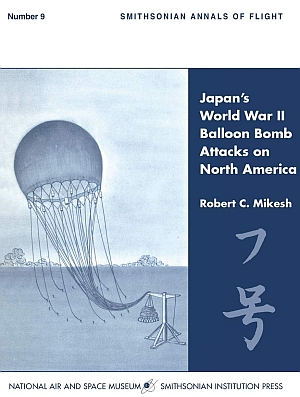Japan's World War II Balloon Bomb Attacks on North America (Book)

Robert C. Mikesh's Japan's World War II Balloon Bomb Attacks on North America offers a comprehensive and meticulously researched account of one of World War II's most unusual military operations. This 85-page volume, first published in 1973 by the Smithsonian Institution Press as part of their Smithsonian Anals of Flight series, delves into the Japanese Fu-Go campaign, wherein over 9,000 hydrogen-filled balloons equipped with incendiary and anti-personnel bombs were launched across the Pacific Ocean between November 1944 and April 1945. The objective was to exploit the jet stream to carry these balloons to North America, aiming to ignite forest fires, cause civilian casualties, and instill fear among the American population.
Mikesh's narrative begins with the conceptualization and development of the Fu-Go balloons, highlighting the innovative yet rudimentary technology employed. He details the construction process, noting the use of washi paper and konnyaku paste, and the involvement of Japanese schoolgirls in assembling the balloons. The book also examines the sophisticated altitude control mechanisms designed to maintain the balloons' flight over vast distances.
The author provides an in-depth analysis of the operational aspects of the campaign, including the strategic rationale behind the attacks and the logistical challenges faced by the Japanese military. He chronicles the trajectory of the balloons, many of which landed across the western United States, Canada, and even as far east as Michigan. Despite the large number launched, the campaign resulted in minimal damage, with the most tragic incident occurring in May 1945, when a balloon explosion in Oregon claimed the lives of six civilians, the only fatalities on the U.S. mainland due to enemy action during the war.
Mikesh's work is notable for its extensive use of visual aids, including photographs, maps, diagrams, and wiring schematics, which enhance the reader's understanding of the technical and operational facets of the Fu-Go campaign. The book also explores the American response to the balloon threat, detailing the censorship efforts to prevent public panic and the military's attempts to intercept and analyze the balloons.
While the Fu-Go campaign ultimately failed to achieve its intended objectives, Mikesh's thorough documentation provides valuable insights into this obscure chapter of World War II history. His balanced and detailed account serves as an essential resource for historians and enthusiasts interested in unconventional warfare and the broader implications of the Fu-Go attacks on North American soil.
The book is available for free in PDF format at the Smithsonian Libraries and Archives website (see the link below).

